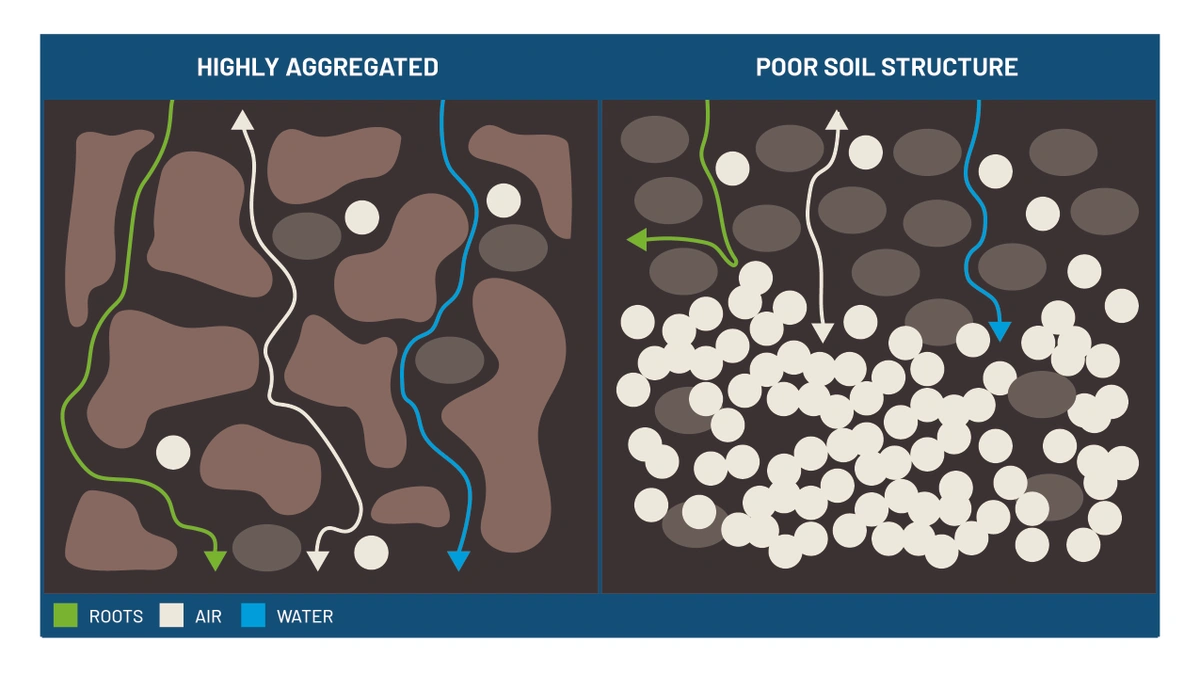Aggregate stability: What it does and how to use it
Summary: Aggregate stability provides not only an indicator of past practices, but also an important component of healthy, productive soil.

Certainly we’ve all heard of soil carbon and soil organic matter by now and know they are key to healthy, productive soils. But perhaps you haven’t heard much about aggregate stability and its soil function.
Aggregate stability is the ability of a soil aggregate to remain intact… basically the measure of a soil’s physical strength. The higher the soil’s aggregate stability, the more that soil can withstand tractor traffic without compaction or erosion. Also, aggregate stability helps maintain and build water infiltration, deep soil water percolation, and water holding capacity, along with aggregate surface space for nutrient exchange.

Simply put, improving aggregate stability improves all of these functions, which in turn translates into:
- improved drought resistance
- increased ability to drain excess moisture
- faster field accessibility after a rain event
- compaction avoidance
- improved ability to deliver nutrients to plants
- reduced erosion
The strategy to improve soil aggregate stability is straightforward: 1) reduce tillage, 2) increase the time the soil has living roots in it, 3) increase the amount of residue on the soil surface, and 4) encourage earthworm populations. In essence, carbon farming practices help you to not only sequester carbon in your soils but also improve aggregate stability as well. Stacking multiple carbon farming practices will also increase the speed at which soil aggregate stability is accumulated.
There are a few ways to measure your soil’s aggregate stability as it changes over time:
- The Slake test: Place a dry chunk of soil in a wire mesh container and then submerge the soil at the surface of a container of water. Measure the amount of soil that slakes off the chunk in a given period, or how long it takes for the soil chunk to fully lose its structure. The longer it takes for the soil clod or chunk to slake or lose its structure, the better your soil’s aggregate stability. Of course, soil type will have an impact on aggregate stability, but management will also have an impact.
- Earthworm Check: Pull up a fistful of soil. Observe the number of earthworms or evidence of earthworms (middens, castings, channels). Increases in earthworms are not only evidence that your carbon farming practices have been working to increase soil aggregation, but they also increase aggregation themselves.
- Squeeze Test: Pull up a fistful of soil (preferably dry) and squeeze it until it breaks apart. Observe the size of the resulting particles. Soil that gives a little and then breaks into larger soil particles indicates better aggregation. If the soil doesn’t break at all or breaks into dust, there is likely very poor aggregation.
Changes in aggregate stability will not occur overnight, but it does provide one indication of progress on soil health you can track on a yearly basis.
The Carbon by Indigo program provides free agronomic assistance to help farmers figure out the right practices to boost aggregate stability, while also improving many other elements of soil health and earning additional income from carbon credits. Want to learn more? Speak to a regenerative farming expert by reaching out here.


